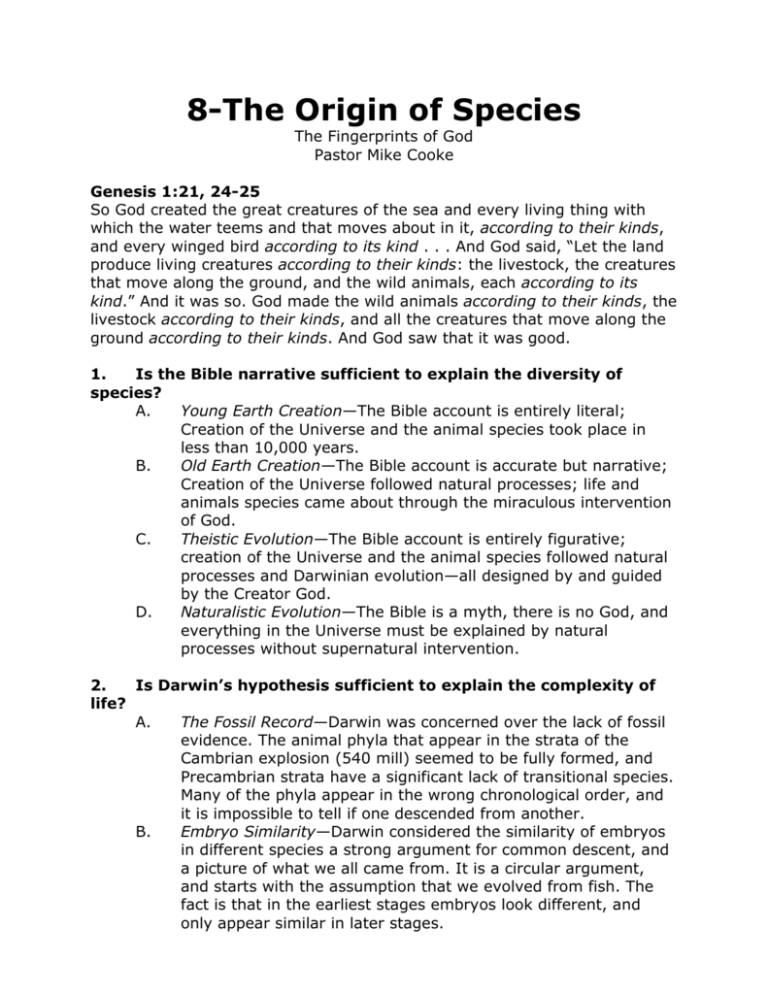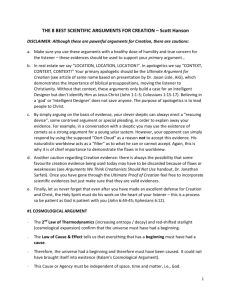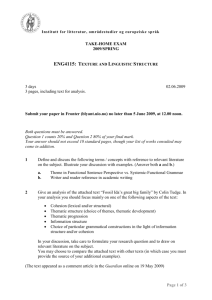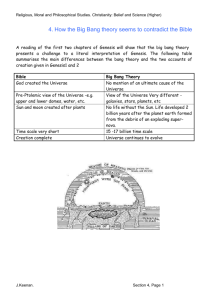8-the_origin_of_spec..
advertisement

8-The Origin of Species The Fingerprints of God Pastor Mike Cooke Genesis 1:21, 24-25 So God created the great creatures of the sea and every living thing with which the water teems and that moves about in it, according to their kinds, and every winged bird according to its kind . . . And God said, “Let the land produce living creatures according to their kinds: the livestock, the creatures that move along the ground, and the wild animals, each according to its kind.” And it was so. God made the wild animals according to their kinds, the livestock according to their kinds, and all the creatures that move along the ground according to their kinds. And God saw that it was good. 1. Is the Bible narrative sufficient to explain the diversity of species? A. Young Earth Creation—The Bible account is entirely literal; Creation of the Universe and the animal species took place in less than 10,000 years. B. Old Earth Creation—The Bible account is accurate but narrative; Creation of the Universe followed natural processes; life and animals species came about through the miraculous intervention of God. C. Theistic Evolution—The Bible account is entirely figurative; creation of the Universe and the animal species followed natural processes and Darwinian evolution—all designed by and guided by the Creator God. D. Naturalistic Evolution—The Bible is a myth, there is no God, and everything in the Universe must be explained by natural processes without supernatural intervention. 2. Is Darwin’s hypothesis sufficient to explain the complexity of life? A. The Fossil Record—Darwin was concerned over the lack of fossil evidence. The animal phyla that appear in the strata of the Cambrian explosion (540 mill) seemed to be fully formed, and Precambrian strata have a significant lack of transitional species. Many of the phyla appear in the wrong chronological order, and it is impossible to tell if one descended from another. B. Embryo Similarity—Darwin considered the similarity of embryos in different species a strong argument for common descent, and a picture of what we all came from. It is a circular argument, and starts with the assumption that we evolved from fish. The fact is that in the earliest stages embryos look different, and only appear similar in later stages. C. D. E. F. G. H. I. Vestigial Organs—Darwin saw organs that once had a purpose but are now useless, such as the appendix, as an argument against Creation. It has since been found that the appendix has actual functions, as well as other such parts. Similarities in Animal DNA—Since the mapping of the human genome and others, the similarities between human and chimp DNA, and others, has been used as an argument for common ancestry. Like the embryo argument, this ignores the similarity being due to a common Creator, or similarity in biological functions. Junk DNA—It has also been argued that a high percentage of DNA is left over from the evolutionary process represented by dead genes. In recent years, it has been found that virtually all of DNA is transcribed by RNA, and more and more regulatory functions are being found for those considered unnecessary. Biogeography—Darwin argued that the absence of certain species where migration was impossible proved that they have to come from a common geography. Many anomalies such as flightless birds and freshwater crabs argue against this notion. Natural Selection—Darwinists argue that mutations such as spots on moths and finch beaks which adapted due to the environment proved that natural selection occurred. These tend to be minor changes within a species, however, and have reverted over time. New Species—In order for Darwinism to work, one species must evolve into another, capable of breeding and producing offspring that breed. Apart from a few experiments with hybridizing plants, and production of closely related sister species, this is not observed in nature. Bacterial Adaptation—Scientists observe bacteria evolving over time, becoming more and more resistant to antibiotics. Microevolution is not proof of more complex evolution as these strains predate human chemistry. According to Faze Ranale, evolution has only been observed in species with a population of 1 quadrillion, generation time of 3 months, and a body size of less than 2 cm.











